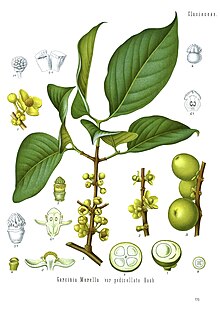Garcinia morella
| Garcinia morella | |
|---|---|
 |
|
| Scientific classification | |
| Kingdom: | Plantae |
| (unranked): | Angiosperms |
| (unranked): | Eudicots |
| (unranked): | Rosids |
| Order: | Malpighiales |
| Family: | Clusiaceae |
| Subfamily: | Clusioideae |
| Tribe: | Garcinieae |
| Genus: | Garcinia |
| Species: | G. morella |
| Binomial name | |
|
Garcinia morella (Gaertn.) Desr. |
|
| Synonyms | |
|
Garcinia gaudichaudii , Mangostana morella Gaertn. , Garcinia elliptica Wall. , Garcinia guttaWt. |
|
Garcinia gaudichaudii , Mangostana morella Gaertn. , Garcinia elliptica Wall. , Garcinia guttaWt.
Garcinia morella is a species of tree in the Clusiaceae family found in India, Sri Lanka and southern Philippines.
Trees are up to 12 m tall. Bark is smooth, and dark brown in color; blaze white.
Leaves simple, opposite, decussate; petiole 0.6-1.5 cm long, canaliculate, sheathing at base, glabrous; lamina 6.5-15 x 3.5-8 cm, usually elliptic, sometimes narrow obovate, apex acute to acuminate, base attenuate; coriaceous or subcoriaceous, glabrous; secondary_nerves 6-8 pairs; tertiary_nerves obscure.
Flowers show inflorescence and are dioecious; male flowers in fascicles, axillary; female flowers larger than male, solitary, axillary.
Ripe fruits can be eaten but they are very acidic. Just like other garcinia varieties such as kokum (which is prevalent in the Indian west coast) or garcinia pedunculata, the fruit can be preserved by slicing into thin pieces and then drying under sun. It can be made into pickles. Bodos cook the unripe fruit as vegetable with fish. A chutney can be made by boiling the fruit. In Assam, dried and preserved slices are added to black green pulses to make a popular slightly acidic curry. Dried up fruit slices are valued as a traditional remedy for dysentery. In Ayurveda the fruits are used in the treatment of dysentery, gastritis, etc. and is said to have anti inflammatory properties. When the bark is cut it exudes a yellow resin called gamboge that is used in food, paints and medicines. It can be used as a rootstock for the mangosteen (Garcinia mangostana).
The xanthonoids gaudichaudione A, B, C, D, E, F, G, H, gaudichaudiic acid A, B, C, D, E, morellic acid and forbesione from G. gaudichaudii.
...
Wikipedia
